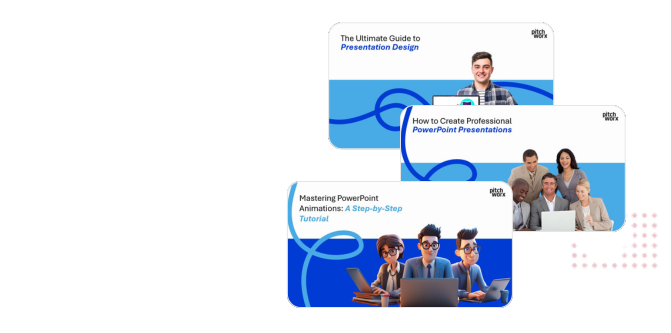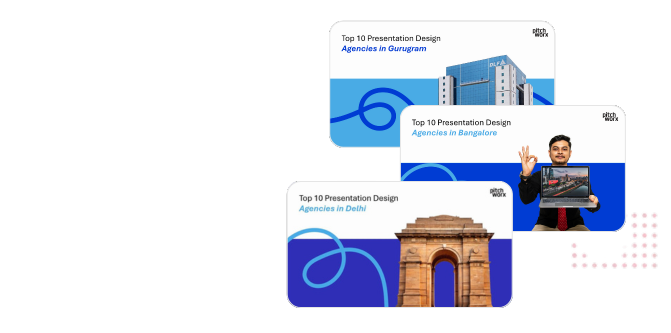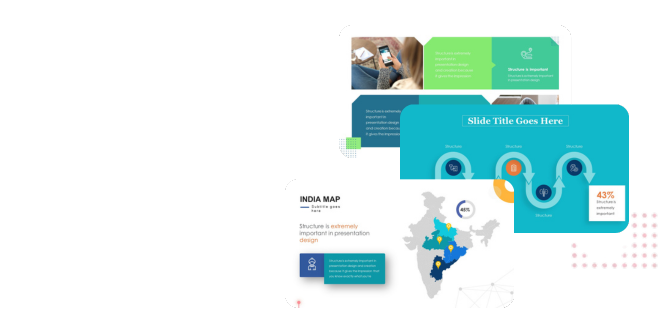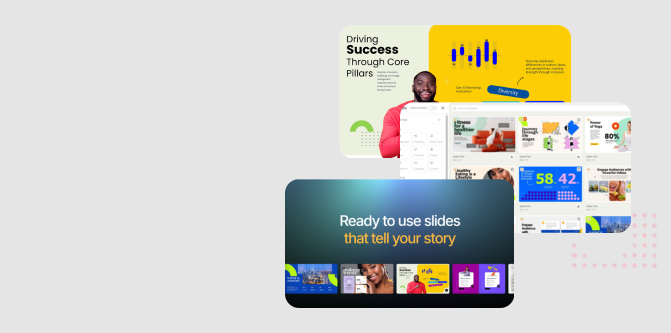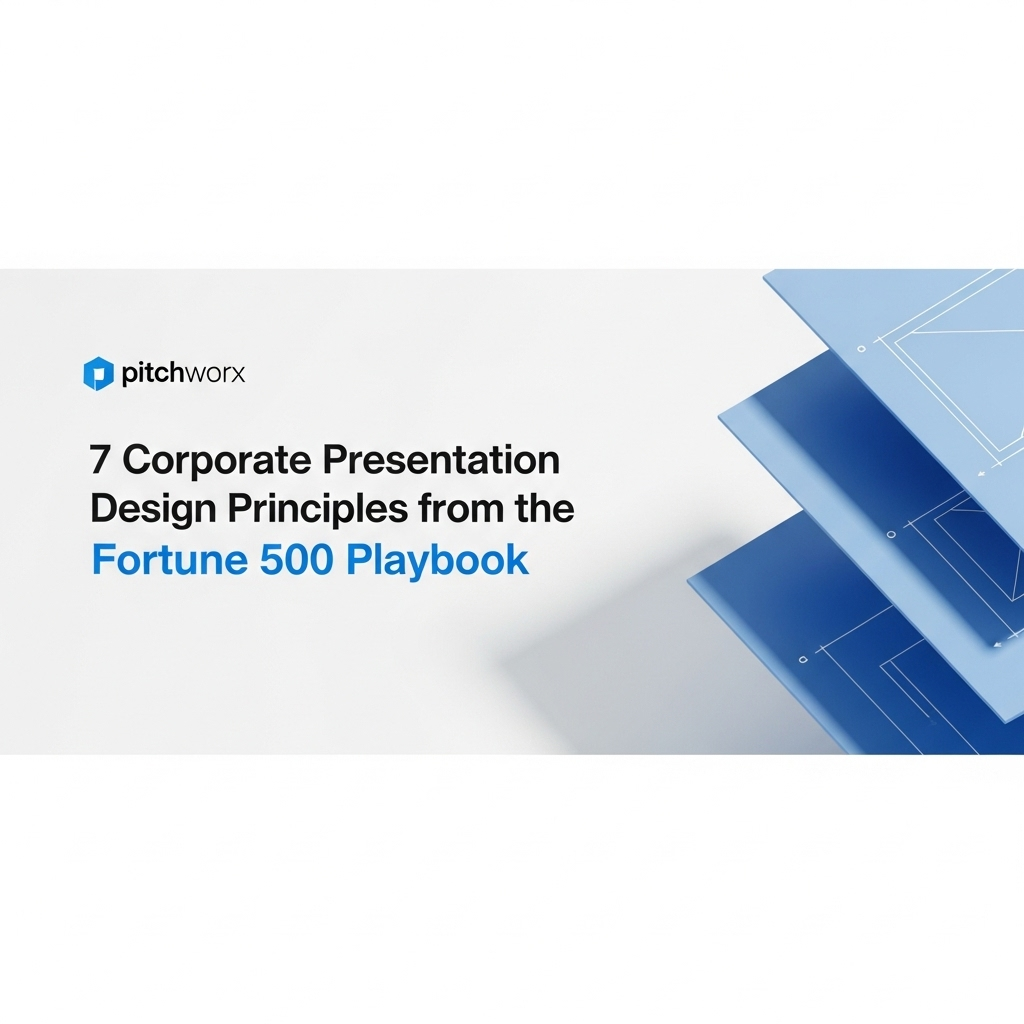Deconstructing the Fortune 500 Communication Playbook
When a Fortune 500 company presents, the stakes are astronomical. Decisions worth billions are made based on the clarity and impact of their slides. This isn’t about flashy animations or dense spreadsheets; it’s about a disciplined, strategic approach to communication. Effective corporate presentation design is a core competency for these organizations, not an afterthought. They understand that a presentation is a critical business asset, engineered to drive action. After more than a decade of crafting high-stakes corporate decks for executive teams, we’ve analyzed and distilled the principles that separate elite presentations from the noise. It’s a framework built on strategic clarity, scalable brand cohesion, and a relentless focus on the decision-maker.
This article breaks down that framework. We will move beyond generic tips and explore the architectural pillars that uphold communication in the world’s most successful companies. You’ll learn how they leverage narrative, data, and design to maintain alignment, persuade stakeholders, and execute strategy at a global scale. These are not just best practices; they are the operational standards for high-consequence communication.
Quick Answer
Corporate presentation design for top-tier companies focuses on driving decisions through strategic communication. With executives making decisions faster than ever, clarity is paramount. Research from McKinsey shows data-driven organizations are 23 times more likely to acquire customers, a process often starting with a presentation. Success relies on:
- Building a strategic narrative that provides context for data.
- Ensuring absolute brand cohesion across all materials.
- Designing data visualizations for executive decision-making.
Table of Contents
- Deconstructing the Fortune 500 Communication Playbook
- The Fortune 500 Blueprint: A Framework for Elite Corporate Presentation Design
- Pillar 1: Strategic Narrative Over Data Dumps
- Pillar 2: Brand Cohesion and Scalability
- Pillar 3: Data Visualization as a Decision-Making Tool
- Pillar 4: Engineered Minimalism for Executive Audiences
- Integrating the Blueprint: From Theory to Practice
- Frequently Asked Questions
- Conclusion: Build Communication Assets, Not Just Slides
The Fortune 500 Blueprint: A Framework for Elite Corporate Presentation Design
Top-performing organizations don’t treat each presentation as a blank canvas. Instead, they operate from a strategic blueprint—a unified framework that governs how they communicate internally and externally. This isn’t just a template with a logo; it’s a comprehensive system of logic, messaging, and visual standards that ensures every presentation, regardless of the author or department, speaks with one powerful, coherent voice. This blueprint is designed for efficiency, clarity, and impact at an enterprise scale.
The core purpose of this framework is to reduce cognitive load for the audience. When executives see a presentation from their own company, they shouldn’t have to waste mental energy decoding the layout, colors, or chart styles. The design should be an invisible carrier for the message. This consistency builds trust and allows the audience to focus entirely on the substance of the information, leading to faster, more informed decisions. The following pillars represent the essential components of this powerful communication blueprint.
Pillar 1: Strategic Narrative Over Data Dumps
The most common mistake we see in corporate presentations is the “data dump”—a series of disconnected charts and bullet points that leave the audience to connect the dots. Fortune 500 leaders know that data has no meaning without context, and context is built through narrative. A strategic narrative is the central storyline that frames the problem, explains the data, and guides the audience toward a desired conclusion. It’s the difference between showing a bar chart of declining sales and telling the story of shifting market dynamics that require a strategic pivot.
The Science of Story
This approach is grounded in neuroscience. As detailed in research covered by Harvard Business Review, stories stimulate the brain and increase retention far more effectively than raw data. When presented with a story, our brains release oxytocin, a neurochemical that enhances our sense of empathy and connection, making the message more memorable and persuasive. Top-tier presentations are structured like a story, with a clear beginning (the challenge), middle (the analysis and insights), and end (the recommendation and call to action).
PitchWorx Insight: The “Why” Before the “What”
In our client engagements, we dedicate the initial discovery phase exclusively to uncovering this narrative. Before a single slide is designed, we work with stakeholders to answer critical questions: What is the one core message we need the audience to remember? What decision do we need to drive? What are the potential objections, and how does our story address them? By establishing the “why” before the “what,” the presentation transforms from a report into a tool of influence.
Pillar 2: Brand Cohesion and Scalability
A Fortune 500 company might produce thousands of presentations a year across dozens of departments and countries. Without a robust system, the brand’s visual identity would quickly fracture, leading to a confusing and unprofessional audience experience. Brand cohesion in presentations is about more than just using the right logo and color palette; it’s about creating a scalable design system that ensures consistency everywhere.
This system typically includes a master template with a library of pre-designed, pre-approved slide layouts for various content types—financial charts, team structures, process flows, timelines, and more. Our PowerPoint design approach prioritizes building these flexible systems for clients. This empowers teams to create on-brand presentations quickly without needing design expertise for every small update. It provides freedom within a framework, ensuring all communications feel like they come from one unified organization.
| Aspect | Siloed Design (The Common Approach) | Cohesive System (The Fortune 500 Approach) |
|---|---|---|
| Consistency | Each presentation looks different, causing brand fragmentation. | All presentations share a unified visual language, reinforcing the brand. |
| Efficiency | Employees waste hours formatting slides from scratch. | Pre-built layouts and assets dramatically speed up creation time. |
| Quality Control | Prone to errors, off-brand colors, and inconsistent data display. | Centralized master templates ensure quality and accuracy. |
| Audience Experience | Cognitive load is high as the audience must re-learn the layout each time. | Familiarity allows the audience to focus on the message, not the design. |
Pillar 3: Data Visualization as a Decision-Making Tool
In a corporate setting, charts and graphs are not decorations; they are tools for analysis and decision-making. Fortune 500 presentations treat data visualization with immense discipline. The goal is not to be flashy but to be immediately understandable. Every chart is optimized to answer a specific business question. This means stripping away extraneous elements—what design expert Edward Tufte calls “chartjunk”—like 3D effects, heavy gridlines, and unnecessary labels, to maximize the data-ink ratio.
They use visual cues strategically. For example, a single element in a line chart might be colored differently to draw attention to a key insight. A title won’t just say “Q3 Sales”; it will say “Q3 Sales Growth Driven by New Enterprise Segment.” This “assertion-based” headline tells the audience what to conclude from the data, guiding their interpretation. This level of clarity is especially critical in materials like investor pitch decks where every data point must defend the core business case. According to a Gartner report on data and analytics trends, value optimization is a key theme, where data is explicitly managed and leveraged as a financial asset. Effective presentation of that data is the final, critical step in realizing its value.
About PitchWorx
With 13+ years of presentation design experience and 150,000+ slides created, PitchWorx is an ISO 27001 certified agency trusted by Fortune 500 companies across US, India, and UAE markets. We transform complex data and ideas into clear, persuasive visual narratives that drive business outcomes.
Pillar 4: Engineered Minimalism for Executive Audiences
The higher you go up the corporate ladder, the simpler the slides become. Executive presentations are exercises in radical minimalism. C-suite leaders are incredibly time-poor and need to absorb information almost instantly. This means high signal-to-noise ratio is a non-negotiable design principle. Every element on the slide—every word, every line, every icon—must serve a purpose. If it doesn’t add to the core message, it’s removed.
This often translates to the “one idea per slide” rule. Instead of crowding multiple charts and takeaways onto a single slide, a complex topic is broken down into a sequence of simple, digestible slides. This allows the presenter to control the flow of information and ensures the audience fully grasps each point before moving to the next. The design is clean, using generous white space to create a sense of calm and focus. As neuroscience cited in a Forbes article highlights, the brain processes visuals 60,000 times faster than text, but this advantage is lost if the visual field is cluttered.
Customer Acquisition Lift
23x Higher
Data-driven organizations are 23 times more likely to acquire customers. (Source: McKinsey)
Integrating the Blueprint: From Theory to Practice
Adopting a Fortune 500-level presentation framework is a strategic initiative that requires commitment, but the payoff in clarity and efficiency is enormous. The process involves more than just design; it’s a change in how an organization approaches communication.
Key Implementation Steps
- Communication Audit: The first step is to gather a wide sample of existing presentations from various departments. This helps identify common inconsistencies, recurring content needs, and areas of brand fragmentation. It provides the baseline for what the new system needs to solve.
- Develop the Core Narrative: Work with leadership to codify the company’s core messaging pillars. What are the key stories about your mission, value proposition, and strategy? These narratives become the foundation for all communication.
- Build the Master Design System: This is the most intensive phase, where the visual language is defined and the master template and asset library are built. This should be done by professional designers who understand both brand strategy and the technical nuances of presentation software.
- Training and Rollout: A new system is only effective if people use it. The rollout should be accompanied by training sessions that explain not just how to use the template, but why the new approach is important for the business. As an agency serving clients across the US, we’ve seen that successful adoption hinges on clear communication and demonstrating the direct benefits to employees’ workflows.
Related Services
Frequently Asked Questions
1. What is the most significant difference in corporate presentation design between a startup and a Fortune 500 company?
The primary difference is scale and systemization. A startup’s presentations are often created ad-hoc for specific pitches, prioritizing agility. A Fortune 500 company requires a scalable design system to ensure brand consistency and messaging alignment across thousands of employees and presentations. Their focus is on building a reliable communication machine, not just a single, perfect deck.
2. How much content is too much for one slide?
For executive audiences, the guiding principle is “one core idea per slide.” If you need more than a single, clear headline and a simple visual (like a chart or icon) to explain the point, you likely have too much content. Breaking a complex idea into a sequence of simpler slides is almost always more effective than creating one dense, overloaded slide.
3. Are presentation templates restrictive for creativity?
A well-designed template is liberating, not restrictive. It handles the foundational design elements (color, typography, layout grids), freeing the user to focus on the quality of the content and message. By providing a flexible library of pre-designed layouts for different content types, it enables creativity within a consistent and professional framework, preventing wasted time on basic formatting.
4. Why is storytelling so important in a data-heavy business presentation?
Data provides evidence, but storytelling creates meaning and drives action. As research from organizations like McKinsey emphasizes, data alone is often not enough to persuade. A narrative structure frames the data, explains its significance, and connects it to a business outcome. This makes complex information more memorable, relatable, and ultimately, more persuasive for decision-makers.
5. How do you measure the ROI of professional corporate presentation design?
ROI can be measured through both qualitative and quantitative metrics. Quantitatively, you can track employee time saved in presentation creation after implementing a design system. Qualitatively, you can measure improved message clarity, faster alignment in meetings, higher stakeholder engagement, and increased confidence from the sales and leadership teams when presenting.
6. What is the role of the presenter’s script in relation to the slide design?
The slides should support the presenter, not replace them. In the Fortune 500 approach, slides are visual signposts that reinforce the key points of the narrative being delivered by the speaker. The script contains the detail, nuance, and persuasive language, while the slides provide the visual evidence and structure. The two work in tandem; one should not simply be a teleprompter for the other.
Conclusion: Build Communication Assets, Not Just Slides
The world’s leading companies have long understood that a presentation is not a disposable document. It is a strategic asset that, when executed correctly, can align teams, win clients, and secure investments. Their approach to corporate presentation design is not about decoration; it’s a discipline rooted in the architecture of communication. By building a blueprint based on strategic narrative, brand cohesion, decision-driven data visualization, and executive minimalism, they create a powerful competitive advantage.
Adopting these principles allows any organization to elevate its communication from simple reporting to strategic influence. It requires a shift in mindset: stop making slides and start engineering communication assets. By doing so, you ensure your most important messages are delivered with the clarity, consistency, and impact they deserve.
Ready to elevate your presentations to a Fortune 500 standard? Our presentation design services help businesses across US, India, UAE markets build communication assets that drive results. See the quality of our work in our portfolio.




